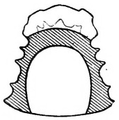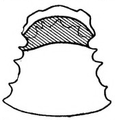Approximants are speech sounds that involve the articulators approaching each other but not narrowly enough nor with enough articulatory precision to create turbulent airflow. Therefore, approximants fall between fricatives, which do produce a turbulent airstream, and vowels, which produce no turbulence. This class is composed of sounds like and semivowels like and, as well as lateral approximants like.
In articulatory phonetics, a consonant is a speech sound that is articulated with complete or partial closure of the vocal tract. Examples are and [b], pronounced with the lips; and [d], pronounced with the front of the tongue; and [g], pronounced with the back of the tongue;, pronounced in the throat;, [v], and, pronounced by forcing air through a narrow channel (fricatives); and and, which have air flowing through the nose (nasals). Contrasting with consonants are vowels.
A fricative is a consonant produced by forcing air through a narrow channel made by placing two articulators close together. These may be the lower lip against the upper teeth, in the case of ; the back of the tongue against the soft palate in the case of German ; or the side of the tongue against the molars, in the case of Welsh. This turbulent airflow is called frication.

The International Phonetic Alphabet (IPA) is an alphabetic system of phonetic notation based primarily on the Latin script. It was devised by the International Phonetic Association in the late 19th century as a standardized representation of speech sounds in written form. The IPA is used by lexicographers, foreign language students and teachers, linguists, speech–language pathologists, singers, actors, constructed language creators, and translators.
A lateral is a consonant in which the airstream proceeds along one or both of the sides of the tongue, but it is blocked by the tongue from going through the middle of the mouth. An example of a lateral consonant is the English L, as in Larry. Lateral consonants contrast with central consonants, in which the airstream flows through the center of the mouth.
In phonetics, liquids are a class of consonants consisting of voiced lateral approximants like together with rhotics like.

In articulatory phonetics, the manner of articulation is the configuration and interaction of the articulators when making a speech sound. One parameter of manner is stricture, that is, how closely the speech organs approach one another. Others include those involved in the r-like sounds, and the sibilancy of fricatives.
In phonetics, rhotic consonants, or "R-like" sounds, are liquid consonants that are traditionally represented orthographically by symbols derived from the Greek letter rho, including ⟨R⟩, ⟨r⟩ in the Latin script and ⟨Р⟩, ⟨p⟩ in the Cyrillic script. They are transcribed in the International Phonetic Alphabet by upper- or lower-case variants of Roman ⟨R⟩, ⟨r⟩: ⟨r⟩, ⟨ɾ⟩, ⟨ɹ⟩, ⟨ɻ⟩, ⟨ʀ⟩, ⟨ʁ⟩, ⟨ɽ⟩, and ⟨ɺ⟩ as well as by the lower-case turned Roman ⟨a⟩ combined with the "non-syllabic" diacritic, that is ⟨ɐ̯⟩.
An affricate is a consonant that begins as a stop and releases as a fricative, generally with the same place of articulation. It is often difficult to decide if a stop and fricative form a single phoneme or a consonant pair. English has two affricate phonemes, and, often spelled ch and j, respectively.
Uvulars are consonants articulated with the back of the tongue against or near the uvula, that is, further back in the mouth than velar consonants. Uvulars may be stops, fricatives, nasals, trills, or approximants, though the IPA does not provide a separate symbol for the approximant, and the symbol for the voiced fricative is used instead. Uvular affricates can certainly be made but are rare: they occur in some southern High-German dialects, as well as in a few African and Native American languages. Uvular consonants are typically incompatible with advanced tongue root, and they often cause retraction of neighboring vowels.

A retroflex, apico-domal, or cacuminalconsonant is a coronal consonant where the tongue has a flat, concave, or even curled shape, and is articulated between the alveolar ridge and the hard palate. They are sometimes referred to as cerebral consonants—especially in Indology.

The voiced velar approximant is a type of consonantal sound, used in some spoken languages. The symbol in the International Phonetic Alphabet that represents this sound is ⟨ɰ⟩, and the equivalent X-SAMPA symbol is M\.

The voiced dental fricative is a consonant sound used in some spoken languages. It is familiar to English-speakers as the th sound in father. Its symbol in the International Phonetic Alphabet is eth, or and was taken from the Old English and Icelandic letter eth, which could stand for either a voiced or unvoiced (inter)dental non-sibilant fricative. Such fricatives are often called "interdental" because they are often produced with the tongue between the upper and lower teeth, and not just against the back of the upper teeth, as they are with other dental consonants.
A voiceless postalveolar fricative is a type of consonantal sound used in some spoken languages. The International Phonetic Association uses the term voiceless postalveolar fricative only for the sound, but it also describes the voiceless postalveolar non-sibilant fricative, for which there are significant perceptual differences.
In phonetics, nasalization is the production of a sound while the velum is lowered, so that some air escapes through the nose during the production of the sound by the mouth. An archetypal nasal sound is.
In phonetics and phonology, a sonorant or resonant is a speech sound that is produced with continuous, non-turbulent airflow in the vocal tract; these are the manners of articulation that are most often voiced in the world's languages. Vowels are sonorants, as are nasals like and, liquids like and, and semivowels like and. This set of sounds contrasts with the obstruents.
The voiceless palatal lateral fricative is a type of consonantal sound, used in a few spoken languages.
The phonological system of the Polish language is similar in many ways to those of other Slavic languages, although there are some characteristic features found in only a few other languages of the family, such as contrasting postalveolar and alveolo-palatal fricatives and affricates. The vowel system is relatively simple, with just six oral monophthongs and arguably two nasals in traditional speech, while the consonant system is much more complex.
In phonetics and phonology, relative articulation is description of the manner and place of articulation of a speech sound relative to some reference point. Typically, the comparison is made with a default, unmarked articulation of the same phoneme in a neutral sound environment. For example, the English velar consonant is fronted before the vowel compared to articulation of before other vowels. This fronting is called palatalization.






